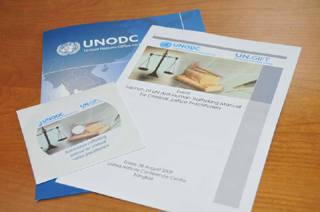|
|
|
|
|
|||||||||||
|
||||||||||||||
|
|
||||||||||||||

Bangkok (Thailand), 28 August 2009 - Today at the United Nations Conference Centre in Bangkok, the
Anti-Human Trafficking Manual for Criminal Justice Practitioners was launched in the presence of several practitioners from the Thai government and UN authorities, as well as members of the media and the civil society.
The
US Ambassador-at-large, Luis CdeBaca launched the UN Manual during a brief ceremony organised by the UNODC Regional Centre for East Asia and the Pacific. Ambassador CdeBaca was appointed by US President Obama in May 2009 to direct the
US State Department's Office to Monitor and Combat Trafficking in Persons. Ambassador CdeBaca was an expert contributor to the UN Manual during the process of its development.
The Training Manual aims to address capacity gaps of criminal justice practitioners working to prevent and combat trafficking in persons, protect and assist its victims, and effectively cooperate with others in doing so. The manual elaborates promising practices in every phase of the criminal justice response to trafficking in persons, and stands as a practical guide and training tool for criminal justice practitioners.

According to the UNODC
Report on the Trafficking in Persons, released in February 2009, the number of convictions of human traffickers is increasing, but unfortunately not in proportion to the growing extent of the problem and the growing awareness of it.
There are several likely reasons for the low number of convictions of human traffickers. One is the absence of anti-trafficking legislation in some countries. In addition, legislation addressing human trafficking does not automatically translate into action by law enforcement officials and prosecutors who may not be properly trained - or motivated - to use it.
Sometimes situations of human trafficking are mistaken for situations of migrant smuggling. This can result in inappropriate and inadequate sentences being applied to crimes. Further to this, sometimes prosecutions are not successful because of the unwillingness of victims to cooperate with the criminal justice system where they have been threatened and intimidated by traffickers.
The
United Nations Anti-Human Trafficking Manual for Criminal Justice Practitioners offers itself as a response to these challenges in securing convictions of human traffickers.
The UN Manual is the product of a broad participatory process involving numerous experts in the field of law enforcement, prosecution and protection and assistance. The process involved contributions from anti-trafficking practitioners from:
The development of the Manual was led by the Anti-Human Trafficking and Migrant Smuggling Unit (AHTMSU) of UNODC and supported by the United Nations Global Initiative to Fight Human Trafficking (UN.GIFT).